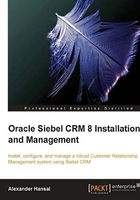
The Siebel File System
Not all data needed by end users such as salespersons or call center agents can be easily stowed away in a set of tables in a relational database. People often rely on graphical information such as charts or images, additional descriptions, documents downloaded from the Internet, spreadsheets, and so on to get a more complete view of the relational data such as the customer information they see in the Siebel client.
Technically, the Siebel File System is a shared directory with a number of subdirectories. Most of these subdirectories are created during the installation process but some are added manually when specialized modules such as Siebel Search are set up.
Whenever an end user, an external system, or internal processes upload file-based information, the file is compressed, and stored in the directory tree. We can see a typical Siebel File System directory tree in the screenshot below:
For files that need to be accessed and downloaded by end users or external systems, Siebel CRM creates a record in a database table that points to the file. Because the files are compressed, and stored in a network share that is typically not accessible by the average user, the level of information security is very high. Even if we could locate a file stored in the Siebel File System, we would not be able to read the information contained in the file unless we uncompressed it using either the Siebel application or command line utilities provided by Oracle.
The following screenshot illustrates how a document attached to a customer record can be located and downloaded from the Siebel Web Client using the Attachments view in the Accounts screen.
A PDF file has been uploaded using the New File button. End users can now access the file by clicking on the hyperlink in the Attachment Name column.

